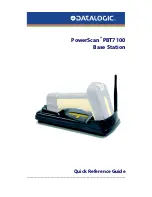
Wiring
Operating Manual PMI 6 primo
1004647-EN-02
25
6
Wiring
6.1
General wiring guidelines
}
Electrical or electronic components which could cause interference (contactors, thyris-
tors, relay coils and solenoid valve coils) should be physically separate from data lines.
We recommend you use a sheet metal (MU metal) bulkhead between both areas.
}
Data cables and power cables should be laid separately to avoid capacitive and induct-
ive transmission (recommended minimum distance = 10 cm/3.94").
}
Shielded data lines should also be laid in a different cable duct to the main power
cables.
}
Power cables should be as short as possible.
}
Power cables should be twisted pair cables.
}
We recommend a max. length of 2 m for the USB cable, to guarantee reliable data
transfer.
}
Use cables with a cross section of 0.5 … 1.0 mm², crimp connectors without plastic col-
lar in accordance with DIN 46228/1 for the fieldbus terminal connections.
6.1.1
Shielding
}
Connect the power cable shield with low impedance to earth.
}
Use only shielded data lines.
}
For high-frequency reasons, we recommend that the shielding on the data line cable
(RS 232 cable) is earthed on both sides. If you are using longer cables and there is the
possibility of transient currents, we recommend one of the following methods:
– Use equipotential bonding conductors
– Use electrical isolation
}
Connect data line shields to a bus bar.
}
Make the connection of the bus bar to the control cabinet/system as short and with as
low impedance as possible.
}
Fasten the braided shield to the shield bar over as large a surface area as possible
(e.g. with metal hose clips or PUK cable clips).
6.1.2
Measures to protect against interference voltages
}
Wire-up inductive loads (e.g. contactor coils, relay coils and solenoid valve coils) using
suppression elements (e.g. RC networks). This is particularly important if these induct-
ive loads are very close to the power supply or are fed from the same supply.
}
If strong magnetic fields are present, we recommend you use a bulkhead separator, i.e.
metal sheet (MU-metal).
















































